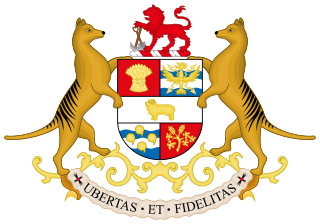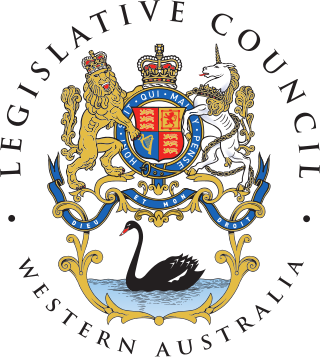Related Research Articles
A constitutional amendment is a modification of the constitution of a polity, organization or other type of entity. Amendments are often interwoven into the relevant sections of an existing constitution, directly altering the text. Conversely, they can be appended to the constitution as supplemental additions, thus changing the frame of government without altering the existing text of the document.
Electoral systems of the Australian states and territories are broadly similar to the electoral system used in federal elections in Australia.

The Constitution of South Africa is the supreme law of the Republic of South Africa. It provides the legal foundation for the existence of the republic, it sets out the rights and duties of its citizens, and defines the structure of the Government. The current constitution, the country's fifth, was drawn up by the Parliament elected in 1994 in the South African general election, 1994. It was promulgated by President Nelson Mandela on 18 December 1996 and came into effect on 4 February 1997, replacing the Interim Constitution of 1993. The first constitution was enacted by the South Africa Act 1909, the longest-lasting to date. Since 1961, the constitutions have promulgated a republican form of government.
The Parliaments of the Australian states and territories are legislative bodies within the federal framework of the Commonwealth of Australia.

The Legislative Council, or upper house, is one of the two chambers of the Parliament of South Australia. Its central purpose is to act as a house of review for legislation passed through the lower house, the House of Assembly. It sits in Parliament House in the state capital, Adelaide.

The Parliament of Tasmania is the bicameral legislature of the Australian state of Tasmania. It follows a Westminster-derived parliamentary system and consists of the Governor of Tasmania, the Tasmanian House of Assembly, and Tasmanian Legislative Council. Since 1841, both Houses have met in Parliament House, Hobart. The Parliament of Tasmania first met in 1856.

The Parliament of Victoria is the bicameral legislature of the Australian state of Victoria that follows a Westminster-derived parliamentary system. It consists of the King, represented by the Governor of Victoria, the Legislative Assembly and the Legislative Council. It has a fused executive drawn from members of both chambers. The parliament meets at Parliament House in the state capital Melbourne. The current Parliament was elected on 26 November 2022, sworn in on 20 December 2022 and is the 60th parliament in Victoria.

The Government of New South Wales, also known as the NSW Government, is the executive branch of state government in New South Wales, Australia, and is empowered by the state Constitution. Since Federation in 1901, New South Wales has been a state of Australia, and the federal Constitution regulates its relationship with the Commonwealth. Under the Australian Constitution, all states ceded legislative and judicial supremacy, but retained powers in all matters not in conflict with the Commonwealth.

The Parliament of New South Wales is a bicameral legislature in the Australian state of New South Wales (NSW), consisting of the New South Wales Legislative Assembly and the New South Wales Legislative Council. Each house is directly elected by the people of New South Wales at elections held approximately every four years. The Parliament derives its authority from the King of Australia, King Charles III, represented by the Governor of New South Wales, who chairs the Executive Council. The parliament shares law making powers with the Australian Federal Parliament. The New South Wales Parliament follows Westminster parliamentary traditions of dress, Green–Red chamber colours and protocols.

The Parliament of South Australia is the bicameral legislature of the Australian state of South Australia. It consists of the 47-seat House of Assembly and the 22-seat Legislative Council. General elections are held every 4 years, with all of the lower house and half of the upper house filled at each election. It follows a Westminster system of parliamentary government with the executive branch required to both sit in parliament and hold the confidence of the House of Assembly. The parliament is based at Parliament House on North Terrace in the state capital of Adelaide.

A Member of the Legislative Assembly (MLA) is a representative elected by the voters of an electoral district (constituency) to the legislature of State government in the Indian system of government. From each constituency, the people elect one representative who then becomes a member of the Legislative Assembly (MLA). Each state has between seven and nine MLAs for every Member of Parliament (MP) that it has in the Lok Sabha, the lower house of India's bicameral parliament. There are also members in three unicameral legislatures in Union Territories: the Delhi Legislative Assembly, Jammu and Kashmir Legislative Assembly and the Puducherry Legislative Assembly. Only a Member of the Legislative Assembly can work as a minister for more than 6 months. If a non-Member of the Legislative Assembly becomes a Chief Minister or a minister, he must become an MLA within 6 months to continue in the job. Only a Member of the Legislative Assembly can become a Speaker of the Legislature.

The Western Australian Legislative Council is the upper house of the Parliament of Western Australia, a state of Australia. It is regarded as a house of review for legislation passed by the Legislative Assembly, the lower house. The two Houses of Parliament sit in Parliament House in the state capital, Perth.

The Parliament of the Cook Islands is the legislature of the Cook Islands. Originally established under New Zealand’s United Nations mandate it became the national legislature on independence in 1965.
A referendum concerning reform of the New South Wales Legislative Council was put to New South Wales voters on 25 May 1991. The referendum coincided with that year's New South Wales general election. The change passed comfortably. The text of the question was:
Do you approve of the Bill entitled 'A Bill for an Act:
(a) to reduce the number of politicians in the Legislative Council and to reduce their maximum term of office; and
(b) to apply to the Legislative Council the same method of filling casual vacancies as applies to the Senate ?

The principles of the current Constitution of South Australia, also known as the South Australian Constitution, which includes the rules and procedures for the government of the State of South Australia, are set out in the Constitution Act 1934. Its long title is "An Act to provide for the Constitution of the State; and for other purposes".

The Constitution of Victoria is the constitution of the state of Victoria, Australia. The current constitution, the Constitution Act 1975 was enacted in 1975, and has been amended several times.
The Constitution Act Further Amendment Act 1881, No. 236 of 1881, long title "An Act to further amend "The Constitution Act"", was an act of the government of South Australia to amend the Constitution of South Australia. Its purpose was to amend the terms of the Constitution Act 1856 in order to increase the size of the Legislative Council of South Australia from 18 to 24 members, and also to divide the province into four electoral districts each to elect six of the members.
Northern District was an electoral district for the Legislative Council of South Australia from 1882 until 1975. Prior to the passing of the Constitution Act Further Amendment Act 1881, the Legislative Council was 18 members elected by people from across the entire Province. From 1975, the Council returned to being elected from the entire state.
Southern District was an electoral district for the Legislative Council of South Australia from 1882 until 1975. Prior to the passing of the Constitution Act Further Amendment Act 1881, the Legislative Council was 18 members elected by people from across the entire Province. From 1975, the Council returned to being elected from the entire state.
Central District was an electoral district for the Legislative Council of South Australia from 1882 until 1912. Prior to the passing of the Constitution Act Further Amendment Act 1881, the Legislative Council had been 18 members elected by people from across the entire Province.
References
- ↑ The Constitution Act Amendment Act (SA)
- ↑ "THE NEW CONSTITUTION". Adelaide Observer . Vol. LVIII, no. 3, 143. South Australia. 28 December 1901. p. 28. Retrieved 2 November 2018– via National Library of Australia.
- ↑ "THE ECONOMY BILL". The Narracoorte Herald . Vol. XXV, no. 2, 291. South Australia. 27 December 1901. p. 2. Retrieved 2 November 2018– via National Library of Australia.